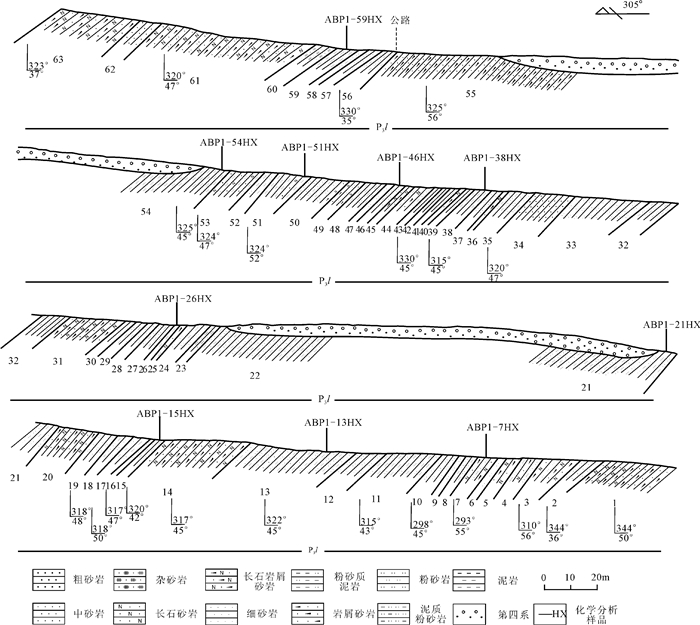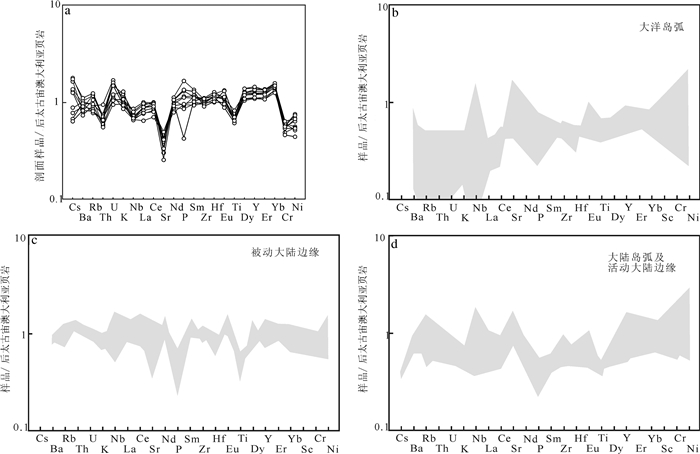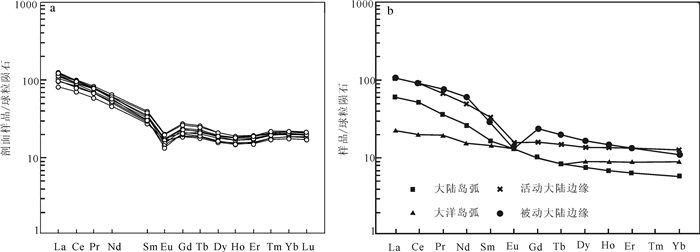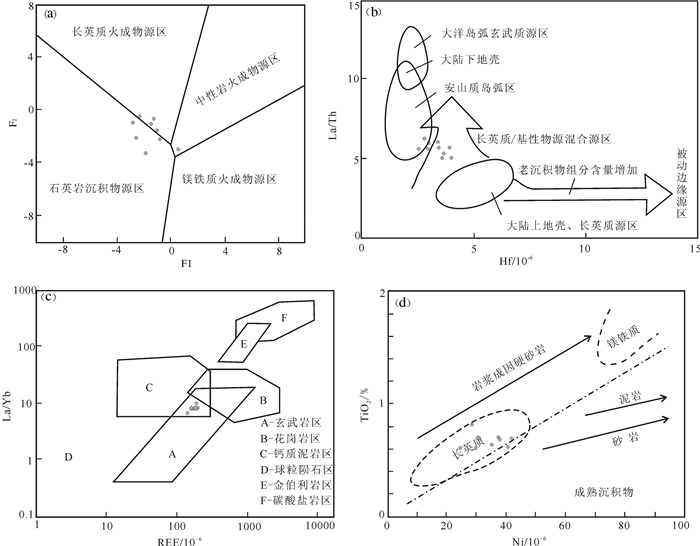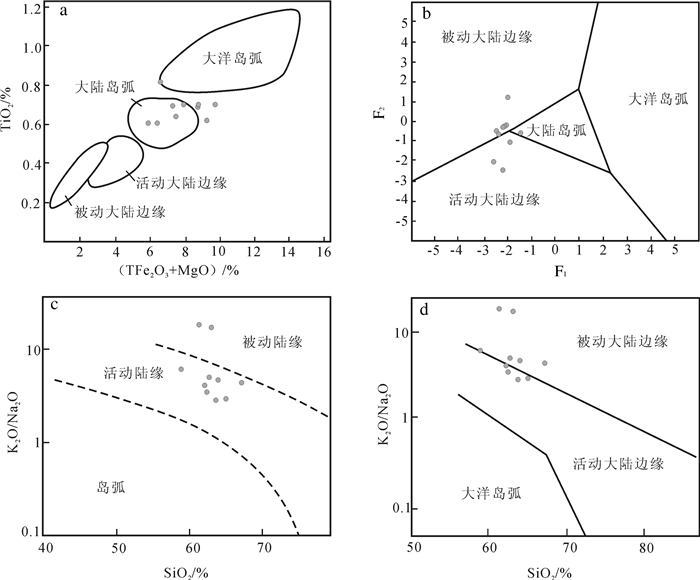Geochemical characteristics of Linxi Formation along Taohaiyingzi section in Ar Horqin Banner, Inner Mongolia, and the constraint on the provenances and the tectonic settings
-
摘要:
大兴安岭中南段上二叠统林西组发育厚层的暗色泥页岩,是区域上重要的上古生界生烃层系之一。阿鲁科尔沁旗陶海营子剖面是林西组的典型剖面之一,本文以该剖面为研究对象,对取自该剖面林西组的10件砂、泥岩样品进行主量元素、微量元素和稀土元素测试分析。剖面样品元素分析和物源判别函数(F1-F2)、Ni-TiO2、La/Th-Hf图解判别结果表明,陶海营子剖面林西组沉积物来源多样,主要来源于上地壳长英质火成物源区和石英岩沉积物源区,还有少量来自中、基性岩火成物源区。剖面样品微量元素PAAS(后太古庙澳大利亚页岩)标准化蛛网图、稀土元素球粒陨石标准化配分模式图、K2O/Na2O-SiO2、Zr/Th、TiO2-(TFe2O3+MgO)图解、物源构造背景判别函数(F1-F2)'的分析判别和剖面样品与不同构造环境砂岩地球化学参数对比结果表明,陶海营子剖面林西组物源构造背景具有被动大陆边缘、活动大陆边缘和大陆岛弧特征,构造背景较复杂。综合分析可知,陶海营子剖面林西组物源主要为被动大陆边缘背景下的火成岩、石英质沉积岩,以及活动大陆边缘和大陆岛弧背景下的火成岩。结合前人相关研究成果,推测兴蒙造山带内伸展作用背景下的晚石炭世-二叠纪岩浆型被动陆缘沉积建造和与俯冲背景有关的古生代弧岩浆岩应该是陶海营子剖面林西组的主要物源。
Abstract:A set of thick-bedded dark muds and shales are developed in Linxi Formation of Upper Permian in south-central part of Da Hinggan Mountains, serving as one of the important Upper Paleozoic hydrocarbon source rock strata in this region. The Taohaiyingzi section in Ar Horqin Banner is one of the most typical sections of Linxi Formation, and the authors took the section as the study area. Test and analysis of major elements, trace elements and rare earth elements were conducted for ten pieces of sand or mud samples of Linxi Formation along the section. The results of element analysis and the diagrams of provenance discrimination function (F1-F2), Ni-TiO2 and La/Th-Hf show that Linxi Formation along the section had several provenances, which mainly included felsic igneous rock provenance and quartzite sedimentary provenance besides a minority of intermediate-basic igneous provenance. Based on the analysis of the spider diagram of trace elements standardized by PAAS, the distribution pattern of rare earth elements standardized by chondrite, the diagrams of K2O/Na2O-SiO2, Zr/Th and TiO2-TFe2O3+MgO and provenance tectonic setting discrimination function (F1-F2)'of the samples of the section, and the sand geochemical parameter contrast between the samples and different tectonic settings, the authors hold that the provenances of Linxi Formation along the section exhibited complex tectonic settings with the characteristics of passive continental margin, active continental margin and continental island arc. The comprehensive analysis shows that the provenances of Linxi Formation of the section consisted of igneous rocks and quartziferous sedimentary rocks under the passive continental margin background, and igneous rocks under the active continental margin and continental island arc background. Combined with the previous related study achievements, it could be concluded that the sedimentary formations of Late Carboniferous to Permian magmatic passive continental margin under extension background and Paleozoic arc magmatic rocks under subduction background in Xing'an-Mongolian Orogenic belt ought to be the primary provenances of Linxi Formation along the section.
-
Keywords:
- Taohaiyingzi section /
- Linxi Formation /
- geochemistry /
- provenance /
- tectonic setting
-
1. 引言
源岩在经历风化、剥蚀、搬运、沉积、固结成岩等作用后形成碎屑沉积岩,在这一过程中,由于某些地化元素在水体中分配系数低、活动性差、不受或较少受成岩及后期改造作用的影响,保存了相当丰富的地质信息,因此这些元素或元素比值的稳定性就为研究沉积岩物源性质及其构造背景等提供了依据(Taylor et al., 1985; Bhatia,1985; Mclennan et al. 1991;Mclennan, 1993;Lev et al., 1998;Savoy et al., 2000)。
大兴安岭中南段上二叠统林西组分布广泛、厚度巨大、暗色泥页岩发育,是重要的生烃层位(张永生等,2011; 张健等,2013)。阿鲁科尔沁旗陶海营子剖面是该区林西组的典型剖面之一。由于目前针对该区林西组物源性质及构造背景的相关研究相对较少,因此本文旨在通过分析陶海营子剖面林西组岩石样品的主量、微量及稀土元素地球化学特征,结合前人相关研究成果,查明该剖面晚二叠世林西组沉积的物源特征及其构造背景,为大兴安岭中南段上二叠统林西组物源-构造背景分析提供新的证据,同时为该区晚二叠世岩相古地理研究提供可靠的地质基础资料。
2. 地质背景
陶海营子剖面位于内蒙古阿鲁科尔沁旗白音塔拉苏木陶海营子村西5 km处,大地构造上位于兴蒙造山带内,林西断裂与西拉木伦断裂之间(Tang et al,1993; Xiao et al., 2003)(图 1)。兴蒙造山带位于中亚造山带东段,构造活动复杂。已有众多学者对该造山带及其周边地区的构造特征进行过相关研究,长久以来围绕华北板块和西伯利亚板块最终的碰撞缝合位置和时代这两个问题争论不休。关于两大板块的最终碰撞缝合位置,一些学者认为是早古生代末期一晚古生代初期贺根山一黑河缝合带(Zhang et. al, 1984;Sengor et al., 1993; Nozaka et al., 2002)而另一些学者认为西拉木伦河一长春一延吉断裂带是两大板块的最后缝合带(李锦轶等,2007;邓胜徽等,2009)。关于两大板块的最终碰撞缝合时间,一些学者认为最终缝合时间为晚二叠世(孙德有等,2004),另一些学者则认为最终缝合时间为早中三叠世( 李锦轶等,2007; 李益龙等,2009; 韩杰等,2011; 韩国卿等,2011; 叶栩松等,2011)。
陶海营子剖面林西组长950 m, 厚度 > 702 m, 未见顶、底,剖面岩性主要为灰黑色、深灰色泥岩、粉砂岩、细砂岩夹中、粗砂岩(图 2),含双壳、叶肢介和孢粉等化石。郑月娟等(2013)通过分析鉴定该剖面中的孢粉、叶肢介等化石组合,认为该剖面林西组地层时代为晚二叠世晚期,相当于林西组上部层位。
3. 样品采集与分析方法
样品采自陶海营子剖面第7~59层中的重点砂泥岩层位,样品数量共计10个,岩性主要为灰黑色泥岩、粉砂质泥岩和深灰色泥质粉砂岩(图 2)。样品前处理和元素地球化学分析(主量、微量、稀土元素)均在中国地质科学院地球物理地球化学勘查研究所完成。其中,主量元素主要采用熔片法X-射线荧光光谱法(XRF)进行测试分析,单位为%,检出限0.05~0.1;微量元素采用压片法X-射线荧光光谱(XRF)、等离子体质谱法(ICP-MS)和发射光谱法(ES)进行测试分析,单位为μg/g,检出限0.01~50;稀土元素采用等离子体质谱法(ICP-MS)进行测试分析,单位为μg/g,检出限0.1~1。测试结果见表 1。
表 1 陶海营子剖面林西组样品主量(%)、微量(10-6)和稀土元素(10-6)分析结果Table 1. Major(%), trace(10-6) and rare earth element(10-6)compositions of the samples from Linxi Formation along Taohaiyingzi section
4. 地球化学特征
4.1 主量元素特征
由表 1可知,样品中SiO2含量为58.93°% ~ 67.19%,平均值为63.07%; Al2O3含量为16.04%~ 18.16%,平均值为16.92%; TiO2含量为0.60% ~ 0.81%,平均值为0.68%; TFe2O3+MgO含量为5.92% ~9.78%,平均值为7.84%; SiO2/Al2O3比值为3.41~ 4.08, 平均值为3.73。这些数值说明各样品中SiO2含量普遍较高,各元素含量整体变化较小、普遍较稳定,样品成熟度相近。
4.2 微量元素特征
在微量元素PAAS (后太古宙澳大利亚页岩)标准化值蛛网图(图 3a)上,样品大体呈现两组特征:第一组亏损Cs、Th、Nb、Sr、Ti、Cr、Ni,富集U、Dy、Y、Er、Yb;第二组亏损Ba、Th、Nb、La、Ce、Sr、Ti、Cr、Ni,富集Cs、U、P、Sm、Hf、Eu、Dy、Y、Er、Yb。共同表现出亏损Th、Nb、Sr、Ti、Cr、Ni,富集U、Dy、Y、Er、Yb。
![]() 图 3 陶海营子剖面林西组样品(a)和不同构造环境下(b,c,d)微量元素蛛网图(沈渭洲等,2009)(标准化数据引自 Taylor et al.,1985)Figure 3. Trace element spider diagrams of the samples of Linxi Formation along Taohaiyingzi section(a)and rocks in different(standard data after Taylor et al.,1985)
图 3 陶海营子剖面林西组样品(a)和不同构造环境下(b,c,d)微量元素蛛网图(沈渭洲等,2009)(标准化数据引自 Taylor et al.,1985)Figure 3. Trace element spider diagrams of the samples of Linxi Formation along Taohaiyingzi section(a)and rocks in different(standard data after Taylor et al.,1985)4.3 稀土元素特征
稀土元素在沉积过程中仅发生较小的变化,具有自身稳定性,因此沉积岩中的稀土元素可以作为研究盆地构造背景和源区地壳属性的依据(Cullers et al., 1975, 1979; Chaudhuri, 1979; Bhatia et al., 1981;Bhatia, 1983)。
陶海营子剖面林西组样品稀土元素总量(ΣREE,不含Y)为139.51×10-6~196.29×10-6平均值为174.52xl0-6, 与北美页岩的平均值(173.2xl0-6, 数据源自Haskin et al., 1968)基本持平。轻稀土总量(ΣLREE)为120.4×10-6~171.2×10-6, 平均值为152.47X 10-6, 占稀土总量的87.37%;重稀土总量(ΣHREE)为19.10×10-6~25.09×10-6, 平均值为22.04×10-6, 占稀土总量的12.63%;轻、重稀土元素比值(ΣLREE/ ΣHREE)为6.30~7.59, 平均值为6.92。(La/Yb)N为4.50~6.56, 平均值为5.49; (Ce/Yb)N为3.90~5.13, 平均值为4.55。
ΣLREE/ΣHREE可反映岩石中轻、重稀土元素的分异程度,(La/Yb)N和(Ce/Yb)N可反映稀土元素分布模式图中分布曲线的倾斜程度。通过分析剖面样品稀土元素数据(表 1)可知,样品轻、重稀土元素分异程度较大。在样品的球粒陨石标准化稀土元素分布模式图(图 4a)上,配分模式曲线明显向右倾斜,说明陶海营子剖面林西组沉积富集轻稀土元素。
![]() 图 4 陶海营子剖面林西组样品(a)和不同构造环境下(b)球粒陨石标准化稀土元素分布模式图(沈渭洲等,2009)球粒陨石标准化值引自Boynton (1984);不同构造环境的原始数据引自Bhatia et al. (1986)Figure 4. Chondrite-normalized REE patterns of the samples of Linxi Formation along Taohaiyingzi section(a) and rocks in different tectonic settings(b)(after Shen Weizhou et al., 2009)Chondrite data after Boynton (1984); primary data of different tectonic environment after Bhatia et al. (1986)
图 4 陶海营子剖面林西组样品(a)和不同构造环境下(b)球粒陨石标准化稀土元素分布模式图(沈渭洲等,2009)球粒陨石标准化值引自Boynton (1984);不同构造环境的原始数据引自Bhatia et al. (1986)Figure 4. Chondrite-normalized REE patterns of the samples of Linxi Formation along Taohaiyingzi section(a) and rocks in different tectonic settings(b)(after Shen Weizhou et al., 2009)Chondrite data after Boynton (1984); primary data of different tectonic environment after Bhatia et al. (1986)5. 讨论
5.1 物源成分
Bhatia(1985)认为沉积物源岩是影响细粒碎屑沉积岩成分的重要因素。反过来,通过研究细粒碎屑沉积岩的成分可以确定其物源的成分。
依据Roser et al.(1988)提出的物源成分判别函数F1、F2公式:


计算出陶海营子剖面林西组样品相应的判别函数值,并投点于物源判别图(图 5a)上。在该图上,10个剖面样品投点中有一半落在石英岩沉积物源区,4个落在长英质火成物源区,还有1个落在中性岩火成物源区。在Floyd et al.(1987)提出的La/ Th−Hf图解(图 5b)中,剖面样品投点中有6个落入长英质和镁铁质物源混合源区内,2个落在安山质岛弧区内,还有2个落于二者的过渡区间。在Allegre et al.(1974)提出的La/Yb−∑REE源岩判别图解(图 5c)中,剖面样品投点集中落在了钙质泥岩区和玄武岩区的混合区内。在Floyd et al.(1989)提出的Ni−TiO2物源成分判别图解(图 5d)上,剖面样品投点全部落在长英质区域内。根据Girty et al. (1996)研究,Al2O3/TiO2比值可用于确定物源区的成分,当该比值介于19~28时,反映物源区成分为长英质岩石。剖面样品Al2O3/TiO2比值为20.83~29.98,平均值为25.26,主要位于长英质岩石比值区间内。根据Wronkiewicz et al.(1989)研究,Cr/Zr比值可用来反映镁铁质岩石和长英质岩石对沉积物的相对贡献,剖面样品Cr/Zr比值0.22~0.37,平均值0.29,明显小于1,说明它们主要来自长英质岩石。剖面样品Ba/Sr比值5.58~13.85,平均值为7.96,明显高于上地壳该比值(1.57,数据源自Taylor et al., 1985),说明它们来自上地壳。综合上述分析可知,陶海营子剖面林西组沉积物主要来源于上地壳的长英质火成物源区和石英岩沉积物源区,还有少量来自中、基性岩火成物源区,说明该剖面林西组沉积物来源多样。
![]() 图 5 陶海营子剖面林西组样品F1-F2(a)、La/Th-Hf (b)、La/Yb-∑REE(c)和Ni-TiO2(d)Figure 5. Provenance discrimination diagrams showing F1-F2(a), La/Th-Hf (b), La/Yb-∑REE(c) and Ni-TiO2(d)of the samples ofLinxi Fromation along Taohaiyingzi section(Allegre et al., 1974; Roser et al., 1988; Floyd et al., 1987, 1989)
图 5 陶海营子剖面林西组样品F1-F2(a)、La/Th-Hf (b)、La/Yb-∑REE(c)和Ni-TiO2(d)Figure 5. Provenance discrimination diagrams showing F1-F2(a), La/Th-Hf (b), La/Yb-∑REE(c) and Ni-TiO2(d)of the samples ofLinxi Fromation along Taohaiyingzi section(Allegre et al., 1974; Roser et al., 1988; Floyd et al., 1987, 1989)5.2 物源构造背景
盆地中的碎屑沉积岩是物源区隆升剥蚀的产物,包含了沉积盆地构造环境等信息,是构造演化的直接证据(沈渭洲等,2009)。分析沉积岩地球化学特征是识别前中生代板块构造背景的重要方法和途径,砂岩中的主量元素、微量元素(尤其是那些相对稳定的)在研究盆地构造背景时是十分有效的(Bhatia et al., 1986)
对比剖面样品微量元素PAAS标准化蛛网图与后太古宙大陆页岩标准化下的大洋岛弧、大陆岛弧及活动大陆边缘、被动大陆边缘特征图(沈渭洲等,2009)可知,陶海营子剖面林西组物源构造背景兼有被动大陆边缘及活动大陆边缘特征(图 3)。对比剖面样品球粒陨石标准化稀土元素分布模式与不同构造环境下该分布模式(沈渭洲等,2009),同样可以发现陶海营子剖面林西组物源构造背景既有被动大陆边缘特征,也有活动大陆边缘特征(图 4)。在Bhatia(1983)提出的(TFe2O3+MgO)-TiO2图解(图 6a)上,剖面样品投点主要落在大陆岛弧区,部分投点落于空白处。按照Bhatia (1983)提出的构造环境判别函数F1和F2的公式:


计算函数值并投点于判别图(F1-F2) ’(图 6b)上,可见剖面样品投点中6个落在被动大陆边缘区域,3个落在活动大陆边缘区域,1个落于大陆岛弧区域。在Murphy(2000)提出的SiO2-K2O/Na2O图解(图 6c)上,剖面样品投点中8个落在活动陆缘区,2个落在被动陆缘区。在Roseretal.(1986)提出的SiO2-K2O/Na2O图解(图 6d)上,剖面样品投点中6个落于被动大陆边缘区,4个落于活动大陆边缘区。同时,将剖面样品与不同构造环境砂岩地球化学参数(Bhatia, 1983; Taylor et al., 1985; 高山等,1999)进行对比(表 2),可以发现剖面样品的地球化学特征与被动大陆边缘和大陆岛弧环境砂岩地球化学特征最为相似,活动大陆边缘次之。造山带周缘盆地中碎屑岩地球化学特征具有构造背景继承性的特征,反映的是源岩形成的构造背景(李双应等,2004),而研究区处于兴蒙造山带之中,由此可知,陶海营子剖面林西组物源构造背景具有被动大陆边缘、活动大陆边缘和大陆岛弧特征,构造背景较复杂。
表 2 陶海营子剖面林西组样品与不同构造环境砂岩地球化学参数对比Table 2. Geochemical parameter comparisons between the samples of Linxi Formation of Taohaiyingzi section and sandstones under different tectonic settings
5.3 物源分析
在陶海营子剖面林西组物源成分和物源构造背景分析的基础上,结合剖面样品采集的相对位置,进一步分析可知:剖面上部沉积物主要来自石英岩沉积物源区和长英质/基性物源混合源区,主要对应被动大陆边缘构造背景; 剖面下部沉积物主要来自长英质火成物源区和安山质岛弧区,对应被动大陆边缘、活动大陆边缘以及大陆岛弧三种构造背景。由此说明,陶海营子剖面林西组物源主要为被动大陆边缘背景下的火成岩、石英质沉积岩,以及活动大陆边缘和大陆岛弧背景下的火成岩。
前人对大兴安岭中南段二叠系砂岩开展过物源相关研究,认为该区二叠纪砂岩主要来自兴蒙造山带(韩国卿等,2011; 赵英利等,2012; 郑月娟等,2014)。何国琦等(1996)和吴泰然等(2007)认为不对称简单剪切模式导致的地壳减薄可能是火山型被动陆缘的成因,对应的沉积建造由陆相沉积物、双峰式火山岩以及稳定陆缘的复理石组合组成。邵济安等(2014, 2015)认为兴蒙造山带在晚石炭世-早二叠世处于年轻陆壳在伸展背景下新生裂陷槽控制同期沉积作用和岩浆活动的阶段,早二叠世大石寨组双峰式火山岩和同期碱性花岗岩、大型基性岩墙群便为岩浆活动的产物。徐备等(2014)认为二叠纪时期兴蒙造山带伸展作用频繁、伸展构造复杂,形成了早-中二叠世沉积建造与火山岩建造同时发育的被动裂谷带、晚二叠世以火成岩组合为主的主动裂谷带等岩石-构造单元。对比前人研究成果,推测兴蒙造山带内伸展作用背景下的晚石炭世-二叠纪岩浆型被动陆缘沉积建造为陶海营子剖面林西组提供了重要的物源。
陈斌等(2001)研究发现苏尼特左旗南发育两期弧岩桨活动(分别发生于490 Ma和310 Ma),并认为该地区的弧岩浆岩是先后两次弧岩浆活动叠加的产物。关庆斌等(2016)认为巴林右旗大石寨组玄武安山岩(结晶年龄为280 Ma)在俯冲的构造背景,形成于岛弧-活动大陆边缘弧的环境。赵英利等(2015)发现大兴安岭中南部上二叠统砂岩LA-ICP-MS U-Pb年代学结果中呈现出多期岩桨弧活动的特点,其年龄峰值分别为270~290 Ma、310 Ma左右、440~510 Ma,认为宝力道岩桨弧、大石寨组火山岩以及早古生代苏尼特岩浆弧提供了主要物源。可见兴蒙造山带内与俯冲背景有关的弧岩浆活动时间跨度大,横跨整个古生代。由此推测兴蒙造山带内与俯冲背景有关的古生代弧岩浆岩为陶海营子剖面林西组提供了重要的物源。
综合上述分析,推测兴蒙造山带内伸展作用背景下的晚石炭世-二叠纪岩浆型被动陆缘沉积建造和与俯冲背景有关的古生代弧岩浆岩应该是陶海营子剖面林西组的主要物源。这与郑月娟等(2014)对陶海营子剖面底部砂岩碎屑锆石测年结果中的锆石年龄组成特征(砂岩中来自古生界的锆石所占比例高达约70%)相一致。
6. 结论
(1) 陶海营子剖面林西组主要来源于上地壳的长英质火成物源区和石英岩沉积物源区,还有少量来自中、基性岩火成物源区;物源构造背景具有被动大陆边缘、活动大陆边缘和大陆岛弧特征; 综合分析可知,物源主要为被动大陆边缘背景下的火成岩、石英质沉积岩,以及活动大陆边缘和大陆岛弧背景下的火成岩。
(2) 结合前人相关研究成果,推测兴蒙造山带内伸展作用背景下的晚石炭世一二叠纪岩浆型被动陆缘沉积建造和与俯冲背景有关的古生代弧岩浆岩是陶海营子剖面林西组的主要物源。
-
图 3 陶海营子剖面林西组样品(a)和不同构造环境下(b,c,d)微量元素蛛网图(沈渭洲等,2009)
(标准化数据引自 Taylor et al.,1985)
Figure 3. Trace element spider diagrams of the samples of Linxi Formation along Taohaiyingzi section(a)and rocks in different
(standard data after Taylor et al.,1985)
图 4 陶海营子剖面林西组样品(a)和不同构造环境下(b)球粒陨石标准化稀土元素分布模式图(沈渭洲等,2009)
球粒陨石标准化值引自Boynton (1984);不同构造环境的原始数据引自Bhatia et al. (1986)
Figure 4. Chondrite-normalized REE patterns of the samples of Linxi Formation along Taohaiyingzi section(a) and rocks in different tectonic settings(b)(after Shen Weizhou et al., 2009)
Chondrite data after Boynton (1984); primary data of different tectonic environment after Bhatia et al. (1986)
图 5 陶海营子剖面林西组样品F1-F2(a)、La/Th-Hf (b)、La/Yb-∑REE(c)和Ni-TiO2(d)
物源判别图解(Allegre et al., 1974;Roser et al., 1988; Floyd et al., 1987, 1989)
Figure 5. Provenance discrimination diagrams showing F1-F2(a), La/Th-Hf (b), La/Yb-∑REE(c) and Ni-TiO2(d)of the samples of
Linxi Fromation along Taohaiyingzi section(Allegre et al., 1974; Roser et al., 1988; Floyd et al., 1987, 1989)
表 1 陶海营子剖面林西组样品主量(%)、微量(10-6)和稀土元素(10-6)分析结果
Table 1 Major(%), trace(10-6) and rare earth element(10-6)compositions of the samples from Linxi Formation along Taohaiyingzi section

表 2 陶海营子剖面林西组样品与不同构造环境砂岩地球化学参数对比
Table 2 Geochemical parameter comparisons between the samples of Linxi Formation of Taohaiyingzi section and sandstones under different tectonic settings

-
Allegre C J, Michard G. 1974. Introduction to Geochemistry(Geophysics and Astophysics Monographs)[M]. Kluwer Academic Publishers, 1-143.
Bhatia M R., Taylor S R. 1981. Trace-element geochemistry and sedimentary provinces:a study from the Tasman Geosyncline, Australia[J]. Chem. Geol., 33:115-125. doi: 10.1016/0009-2541(81)90089-9
Bhatia M R. 1983. Plate tectonics and geochemical composition of sandstones[J]. J. Geol., 91:611-627. doi: 10.1086/628815
Bhatia M R. 1985. Rare earth element geochemistry of Australian Paleozoic greywackes and mudrocks:Provenance and tectonic control[J]. Sedimentary Geology, 45:97-113. doi: 10.1016/0037-0738(85)90025-9
Bhatia M R, 1985. Composition and classification of Paleozoic flysch mudrocks of eastern Australia:Implications in provenance and tectonic setting interpretation[J]. Sediment. Geol., 41:249-268. http://www.sciencedirect.com/science/article/pii/0037073884900654
Bhatia M R, Crook K A W. 1986. Trace element characteristics of graywackes and tectonic setting discrimination of sedimentary basins[J].Contributions to Mineralogy and Petrology, 92:181-193. doi: 10.1007/BF00375292
Boynton W V. 1984. Cosmochemistry of the rare earth elements[C]//Henderson P(ed.). Rare Earth Elements Geochemistry: Developments in Geochemistry. Amesterdam: Elservier, 63-114.
Chaudhuri S., Cullers R.L. 1979. The distribution of rare earth elements in deeply buried Gulf Coast sediments[J]. Chem. Geol., 24:327-328. doi: 10.1016/0009-2541(79)90131-1
Chen Bin, Zhao Guochun, Wilde S. 2001. Subduction-and collisionrelated granitoids from southern Sonidzuoqi, Inner Mongolia:Isotopic ages and tectonic implications[J]. Geological Review, 47:361-367 (in Chinese with English abstract). http://en.cnki.com.cn/Article_en/CJFDTOTAL-DZLP200104005.htm
Cullers R L, Chaudhuri S, Arnold B, Lee M, Wolf C W. 1975. Rare earth distribution in clay minerals and in the clay-sized fraction of the Lower Permian Hakensville and Esbridge shales of Kansas and Oklahoma[J]. Geochimica et Cosmochimica Acta, 39:1691-1703. doi: 10.1016/0016-7037(75)90090-3
Cullers R L, Chaudhuri S, Kilbane N, Koch R. 1979. Rare earths in size fractions and sedimentary rocks of Pennsylvanian-Permian age from the mid-continent of the U.S.A[J]. Geochimica et Cosmochimica Acta, 43:1285-1301. doi: 10.1016/0016-7037(79)90119-4
Floyd P A, Leveridge B E. 1987. Tectonic environment of the Devonian Gramscatho Basin, South Cornwall:Framework mode and geochemical evidence from turhiditie sandstones[J]. J. Geol.Soc., 144:531-542. doi: 10.1144/gsjgs.144.4.0531
Floyd P A, Winchester J A, Park R G. 1989. Geochemistry and tectonic setting of Lewisian clastic metasediments from the early Proterozoic Loch Maree Group of Gairloch, NW Scotland[J]. Precambrian Research, 45:203-214. doi: 10.1016/0301-9268(89)90040-5
Gao Shan, Luo Tingchuan, Zhang Benren, et al. The structure and composition of the crust of East China[J]. Science in China(Series D), 1999, 29(3):204-213 (in Chinese with English abstract). doi: 10.1007-BF02878511/
Girty G H, Ridge D L, Knaack C, Johnson D, Al-riyam R K. 1996. Provenance and depositional setting of Paleozoic chert and argillite, Sierra Nevada, California[J]. Journal of Sedimentary Research, 66:107-118. http://archives.datapages.com/data/sepm/journals/v66-67/data/066/066001/0107.htm
Guan Qingbin, Liu Zhenghong, Bai Xinhui, Li Pengzhuan, Wan Le, Li Shichao. 2016. Age and tectonic setting of volcanic rocks of the Dashizhai Formation from Xinkaiba, Balinyouqi area, Inner Mongolia[J]. Acta Petrologica Sinica, 32(7):2029-2040 (in Chinese with English abstract). http://d.old.wanfangdata.com.cn/Periodical/ysxb98201607007
Han Guoqing, Liu Yongjiang, Wen Quanbo, Li Wei, Wu Linna, Zhao Yingli, Ding Ling, Zhao Limin, Liang Chenyue. 2011. LA-ICP-MS U-Pb dating of detrital zircons from the Permian sandstones in north side of Xar Moron River suture belt and its tectonic implications[J]. Earth Science——Journal of China University of Geosciences, 36(4):687-702 (in Chinese with English abstract). http://d.old.wanfangdata.com.cn/Periodical/dqkx201104009
Han Jie, Zhou Jianbo, Zhang Xinzhou, Qiu Haijun. 2011. Detrital zircon U-Pb dating from sandstone of the Upper Permian Linxi Formation, Linxi area, Inner Mongolia, China and its tectonic implications[J]. Geological Bulletin of China, 30(2/3):258-269(in Chinese with English abstract). http://en.cnki.com.cn/Article_en/CJFDTotal-ZQYD2011Z1012.htm
Haskin L A, Haskin M A, Frey F A, Wildman T R. 1968. Relative and absolute terrestrial abundances of the rare earths[C]//Ahrens L H (ed.).Origin and Distribution of the Elements. Oxford: Pergamon Press, 889-912.
He Guoqi, Li Maosong. 1996. Passive continental margin with magmatism[J]. Beijing Geology, S1:29-33 (in Chinese with English abstract). http://en.cnki.com.cn/Article_en/CJFDTotal-JBDZ6S1.007.htm
Lev S M, Meclennan S M, Meyers W J, Meyers W J, Hanson G N. 1998. A petrographic approach for evaluating trace-element mobility in a black shale[J]. Journal of Sedimentary Research, 68:970-980. doi: 10.2110/jsr.68.970
Li Jinyi, Gao Liming, Sun Guihua, Li Yaping, Wang Yanbin. 2007. Shuangjingzi middle Triassic syn-collisional crust-derived granite in the east Inner Mongolia and its constraint on the timing ofcollision between Siberian and Sino-Korean paleo-plates[J]. Acta Petrologica Sinica, 23(3):565-582. (in Chinese with English abstract). http://en.cnki.com.cn/Article_en/CJFDTOTAL-YSXB200703006.htm
Li Shuangying, Li Renwei, Yue Shucang, Wang Daoxuan, Liu Yin, Meng Qingren, Jin Fuguan. 2004. Geochemistry of Mesozic detrital rocks and its constraints on provenance in Feixi area, Anhui Province[J]. Acta Petrologica Sinica, 20(3):667-676(in Chinese with English abstract). http://en.cnki.com.cn/Article_en/CJFDTOTAL-YSXB200403030.htm
Li Yilong, Zhou Hanwen, Zhong Zengqiu, Zhang Xionghua, Liao Qunan, Ge Mengchun. 2009. Collision processes of North China and Siberian plates:Evidence from LA-ICP-MS zircon U-Pb age on deformed granite in Xar Moron suture zone[J]. Earth Science——Journal of China University of Geosciences, 34(6):931-938(in Chinese with English abstract). doi: 10.3799/dqkx.2009.106
Mclennan S M, Taylor S R. 1991. Sedimentary rocks and crustal evolution:Tectonic setting and secular trends[J]. Journal of Geology, 99:1-21. doi: 10.1086/629470
Mclennan S M. 1993. Weather and global denudation[J]. Geology, 101:295-303. doi: 10.1086/648222
Murphy J B. 2000. Tectonic influence on sedimentation along the southern flank of the late Paleozoic Magdalen basin in the Canadian Appalachians:Geochemical and isotopic constraints on the Horton Group in the St, Marys basin, Nova Scotia[J].Geological Society of America Bulletin, 112:997-1011. doi: 10.1130/0016-7606(2000)112<997:TIOSAT>2.0.CO;2
Nozaka T, Liu Y. 2002. Petrology of the Hegenshan ophiolite and its implication for the tectonic evolution of northern China[J]. Earth and Planetary Science Letters, 202:89-104. doi: 10.1016/S0012-821X(02)00774-4
Roser B P, Korsch R J. 1986. Determ ination of tectonic setting of sandstone mudst one suites using SiO2 content and K2O/Na2O ratio[J]. The Journal of Geology, 94(5):635-650. doi: 10.1086/629071
Roser B P, Korsch R J. 1988. Provenance signatures of sandstone -mudstonesuites determined using discriminant function analysis of major-element data[J].Chemical Geology, 67:119-139. doi: 10.1016/0009-2541(88)90010-1
Savoy L E, Srevenson R K, Mounoy E W. 2000. Provenance of Upper Devonian-Lower Carboniferous Migeoclinal strata, Southeastern Canadian Cordilera:Link between tectonics and sedimentation[J]. Journal of Sedimentary Research, 70:181-193. doi: 10.1306/2DC40909-0E47-11D7-8643000102C1865D
Sengor A M C, Natalin B A, Burtman V S. 1993. Evolution of the Altaid tectonic collage and palaeozoic crustal growth in Eurasia[J]. Nature, 364:299-307. doi: 10.1038/364299a0
Shao Jian, Tang Kedong, He Guoqi. 2014. Early Permian tectono-paleogeographic reconstruction of Inner Mongolia, China[J]. Acta Petrologica Sinica, 30(7):1858-1866 (in Chinese with English abstract).
Shao Jian, He Guoqi, Tang Kedong. 2015. The evolution of Permian continental crust in northern part of North China[J]. Acta Petrologica Sinica, 31:47-55 (in Chinese with English abstract). http://d.old.wanfangdata.com.cn/Periodical/ysxb98201501003
Shen Weizhou, Shu Liangshu, Xiang Lei, Zhang Fangrong, Wang Bo. 2009. Geochemical characteristics of Early Paleozoic sedimentary rocks in the Jinggangshan area, Jiangxi Province and the constraining to the sedimentary environment[J]. Acta Petrologica Sinica, 25(10):2442-2458 (in Chinese with English abstract). http://www.cnki.com.cn/Article/CJFDTotal-YSXB200910013.htm
Sun Deyou, Wu Fuyuan, Zhang Yanbin, Gao Shan. 2004. The final closing time of the west Lamulun River-Changchun-Yanji plate suture zone——Evidence from the Day ushan granitic pluton, Jilin Province[J]. Journal of Jilin University(Earth Science Edition), 34(2):184-181 (in Chinese with English abstract). http://en.cnki.com.cn/Article_en/CJFDTOTAL-CCDZ200402003.htm
Tang Kedong, Yan Zhuyun. 1993. Regional metamorphism and tectonic evolution of the Inner Mongolian suture zone[J], J. Metamorphic Geol., 11:511-522. doi: 10.1111/jmg.1993.11.issue-4
Taylor S R, McLennan S M. 1985. The Continental Crust:Its Composition and Evolution. An Examination of the Geochemical Record Preserved in Sedimentary Rocks[M]. Oxford London:Blackwell Scientific Publication, 1-301.
Wronkiewicz D J, Condie K C. 1989. Geochemistry and provenance of sediments from the Pongola Supergroup, South Afria:Evidence for a 3.0 Ga old continental craton[J]. Geochimica et Cosmochimica Acta, 53:1537-1549. doi: 10.1016/0016-7037(89)90236-6
Wu Tairan, He Guoqi. 2007. Continental breakup and evolution of rifted volcanic margins[J]. Earth Science Frontiers, 14(4):18-25(in Chinese with English abstract). http://en.cnki.com.cn/Article_en/CJFDTOTAL-DXQY200704002.htm
Xiao Wenjiao, Windley B F, Hao Jie, Zhai Mingguo. 2003. Accretion leading to collision and the Permian Solonker suture, Inner Mongolia, China:termination of the central Asian orogenic belt[J]. Tectonics, 22:1069. doi: 10.1029/2002TC001484.
Xu Bei, Zhao Pan, Bao Qingzhong, Zhou Yongheng, Wang Yanyang, Luo Zhiwen.2014. Preliminary study on the pre-Mesozoic tectonic unit division of the Xing-Meng Orogenic Belt(XMOB)[J]. Acta Petrologica Sinica, 30(7):1841-1857 (in Chinese with English abstract). http://d.old.wanfangdata.com.cn/Periodical/ysxb98201407001
Ye Xusong, Liao Qunan, Ge Mengchun.2011. Petrogenesis and tectonic significance of Triassic peraluminous granitoids in Xilinhaote and Linxi area, Inner Mongolia[J].Geological Science and Technology Information, 30(3):57-64 (in Chinese with English abstract). http://www.wanfangdata.com.cn/details/detail.do?_type=perio&id=dzkjqb201103007
Zhang Jian, Bian Xiongfei, Chen Shuwang, Zheng Yuejuan, Tang Youjun, Jiang Xingchao, Gong Fanhao, Huang Xin. 2013. Shale gas resources prospect of late Permian Linxi Formation in the middlesouthern part of the Da Hinggan Mountains[J]. Geological Bulletin of China, 32(8):1297-1306 (in Chinese with English abstract). http://www.wanfangdata.com.cn/details/detail.do?_type=perio&id=zgqydz201308017
Zhang Yongsheng, Wang Yanbin, Lu Zhenquan, Wang Juntao, Su Kui, Fan Fu, Cao Jie, Zeng Yantao 2011. Characteristics of source rocks from Carboniferous-Permian in Songliao Basin and its peripheral area, northeastern China[J]. Geological Bulletin of China, 30(2/3):214-220 (in Chinese with English abstract). http://en.cnki.com.cn/Article_en/CJFDTOTAL-ZQYD2011Z1006.htm
Zhao Yingli, Liu Yongjiang, Han Guoqing, WuLinna, Li Weimin, Wen quanbo, Liang chenyue. 2012. Geochemical characteristics of major elements in the Permian sandstones from the central and southern Great Xing'an Ranges and discriminations on their tectonic environment of the provenance[J]. Journal of Jilin University(Earth Science Edition), 42(Supp.2):285-297 (in Chinese with English abstract). http://www.cnki.com.cn/Article/CJFDTotal-CCDZ2012S2031.htm
Zhao Yingli, Liu Yongjiang, Li Weimin, Wen Quanbo, Feng zhiqiang. 2015. Paleozoic tectonic evolution of south and central section of Greater Khingan Mountains:Evidence from the provenance analyses of sand stones of Linxi Formation of Upper Permian[J]. Journal of Jilin University(Earth Science Edition), 45(S1):1-2(in Chinese).
Zheng Yuejuan J, Zhang Jian, Chen Shuwang, Huang Xin, Zhang Lijun, Wang Wuli. 2013. New fossil discovery along the section of Linxi Formation at Taohaiyingzi in Ar Horqin Banner, Inner Mongolia[J]. Geological Bulletin of China, 32(8):1269-1276 (in Chinese with English abstract). http://www.cqvip.com/QK/95894X/201308/47076946.html
Zheng Yuejuan, Zhang Haihua, Chen Shuwang, Zhang Jian, Huang Xin, Gong Fanhao, Su Fei, Zhen Zhen. 2014. LA-ICP-MS U-Pb age of detrital zircons from Late Permian Linxi Formation in Ar Horqin Banner, Inner Mongolia[J]. Geological Bulletin of China, 33(9):1293-1307 (in Chinese with English abstract). http://www.wanfangdata.com.cn/details/detail.do?_type=perio&id=zgqydz201510011
Zhang ZH M, Liou J G, Coleman R G.1984. An outline of the plate tectonics of China[J]. GSA Bull., 95:295-312. doi: 10.1130/0016-7606(1984)95<295:AOOTPT>2.0.CO;2
陈斌, 赵国春, Wilde S. 2001.内蒙古苏尼特左旗南两类花岗岩同位素年代学及其构造意义[J].地质论评, 47:361-367. doi: 10.3321/j.issn:0371-5736.2001.04.005 邓胜徽, 万传彪, 杨建国.2009.黑龙江阿城晚二叠世安加拉-华夏混生植物群——兼述古亚洲洋的关闭问题[J].中国科学(D辑), 39(12):1744-1752 http://www.cqvip.com/Main/Detail.aspx?id=32628431 高山, 骆庭川, 张本仁, 张宏飞, 韩吟文, 赵志丹. 1999.中国东部地壳的结构和组成[J].中国科学(D辑), 29(3):204-213. http://d.old.wanfangdata.com.cn/Periodical/zgkx-cd199903002 关庆斌, 刘正宏, 白新会, 李鹏川, 万乐, 李世超. 2016.内蒙古巴林右旗新开坝地区大石寨组火山岩形成时代及构造背景[J].岩石学报, 32(7):2029-2040. http://d.old.wanfangdata.com.cn/Periodical/ysxb98201607007 韩国卿, 刘永江, 温泉波, 李伟, 吴琳娜, 赵英利, 丁凌, 赵立敏, 梁琛岳. 2011.西拉木伦河缝合带北侧二叠纪砂岩碎屑锆石LA-ICP-MS U-Pb年代学及其构造意义[J].地球科学——中国地质大学学报, 36(4):687-702. http://d.old.wanfangdata.com.cn/Conference/7414691 韩杰, 周建波, 张兴洲, 邱海峻. 2011.内蒙古林西地区上二叠统林西组砂岩碎屑锆石的年龄及其大地构造意义[J].地质通报, 2011, 30(2/3):258-269. http://d.old.wanfangdata.com.cn/Periodical/zgqydz201102011 何国琦, 李茂松. 1996.关于岩浆型被动陆缘[J].北京地质, S1:29-33. http://www.wanfangdata.com.cn/details/detail.do?_type=perio&id=QK199600258004 李双应, 李任伟, 岳书仓, 王道轩, 刘因, 孟庆任, 金福全. 2004.安徽肥西中生代碎屑岩地球化学特征及其对物源制约[J].岩石学报, 20(3):667-676. http://d.old.wanfangdata.com.cn/Periodical/ysxb98200403030 李锦轶, 高立明, 孙桂华, 李亚萍, 王彦斌.2007.内蒙古东部双井子中三叠世同碰撞壳源花岗岩及其对西伯利亚与中朝古板块碰撞时限的约束[J].岩石学报, 23(3):565-582. http://www.wanfangdata.com.cn/details/detail.do?_type=perio&id=ysxb98200703004 李益龙, 周汉文, 钟增球, 张雄华, 廖群安, 葛梦春. 2009.华北与西伯利亚板块的对接过程:来自西拉木伦缝合带变形花岗岩锆石LA-ICP-MS U-Pb年龄证据[J].地球科学——中国地质大学学报, 34(6):931-938. http://d.old.wanfangdata.com.cn/Periodical/kwysdqhxtb2008z1138 孙德有, 吴福元, 张艳斌, 高山. 2004.西拉木伦河-长春-延吉板块缝合带的最后闭合时间——来自吉林大玉山花岗岩体的证据[J].吉林大学学报(地球科学版), 34(2):174-181. http://d.old.wanfangdata.com.cn/Periodical/cckjdxxb200402003 邵济安, 唐克东, 何国琦. 2014.内蒙古早二叠世构造古地理的再造[J].岩石学报, 30(7):1858-1866. http://d.old.wanfangdata.com.cn/Periodical/ysxb98201407002 邵济安, 何国琦, 唐克东. 2015.华北北部二叠纪陆壳演化[J].岩石学报, 31:47-55. http://d.old.wanfangdata.com.cn/Periodical/ysxb98201501003 沈渭洲, 舒良树, 向磊, 张芳荣, 王博. 2009.江西井冈山地区早古生代沉积岩的地球化学特征及其对沉积环境的制约[J].岩石学报, 25(10):2442-2458. http://d.old.wanfangdata.com.cn/Periodical/ysxb98200910013 吴泰然, 何国琦. 2007.大陆解体与被动陆缘的演化[J].地学前缘, 14(4):18-25. doi: 10.3321/j.issn:1005-2321.2007.04.002 徐备, 赵盼, 鲍庆中, 周永恒, 王炎阳, 罗志文. 2014.兴蒙造山带前中生代构造单元划分初探[J].岩石学报, 30(7):1841-1857. http://d.old.wanfangdata.com.cn/Periodical/ysxb98201407001 叶栩松, 廖群安, 葛梦春. 2011.内蒙古锡林浩特-林西地区三叠纪过铝质花岗岩的成因及构造意义[J].地质科技情报, 30(3):57-64. doi: 10.3969/j.issn.1000-7849.2011.03.007 张健, 卞雄飞, 陈树旺, 郑月娟, 唐友军, 蒋兴超, 公繁浩, 黄欣. 2013.大兴安岭中南部上二叠统林西组页岩气资源前景[J].地质通报, 32(8):1297-1306. doi: 10.3969/j.issn.1671-2552.2013.08.017 张永生, 王延斌, 卢振权, 王俊涛, 苏奎, 樊馥, 曹洁, 曾艳涛. 2011.松辽盆地及外围地区石炭系-二叠系烃源岩的特征[J].地质通报, 30(2/3):214-220. http://d.old.wanfangdata.com.cn/Periodical/zgqydz201102005 赵英利, 刘永江, 韩国卿, 吴琳娜, 李伟民, 温泉波, 梁琛岳. 2012.大兴安岭中南段二叠纪砂岩主量元素地球化学特征及物源区构造环境的判别[J].吉林大学学报(地球科学版), 42(Supp.2):285-297. http://www.wanfangdata.com.cn/details/detail.do?_type=perio&id=QK201205946551 赵英利, 刘永江, 李伟民, 温泉波, 冯志强.2015.大兴安岭中-南段古生代构造演化:来自内蒙东部上二叠统林西组砂岩物源分析的证据[J].吉林大学学报(地球科学版), 45(S1):1-2. http://d.old.wanfangdata.com.cn/Conference/9244448 郑月娟, 张健, 陈树旺, 黄欣张立君王五力. 2013.内蒙古阿鲁科尔沁旗陶海营子剖面林西组化石新发现[J].地质通报, 32(8):1269-1276. doi: 10.3969/j.issn.1671-2552.2013.08.013 郑月娟, 张海华, 陈树旺, 张建, 黄欣, 公繁浩, 苏飞, 甄甄. 2014.内蒙古阿鲁科尔沁旗林西组砂岩LA-ICP-MS锆石U-Pb年龄及意义[J].地质通报, 33(9):1293-1307. doi: 10.3969/j.issn.1671-2552.2014.09.004 -
期刊类型引用(7)
1. 孙杨,谢远云,迟云平,康春国,吴鹏. 大兴安岭东麓龙江县白土山组地层特征:化学风化、沉积循环、源-汇体系和沉积环境. 山地学报. 2022(01): 14-28 .  百度学术
百度学术
2. 仲米山,吕东霖,王岐,张化南,敖光,吴子杰,杨运来,王艺龙,谭超. 大兴安岭中段索伦地区林西组岩石地球化学特征与沉积构造环境. 中国地质调查. 2022(05): 89-96 .  百度学术
百度学术
3. 张海华,李晓海,张健,郑月娟,陈树旺,张德军,苏飞,卞雄飞,孙雷. 松辽盆地北部上二叠统林西组古生物年代学、地球化学特征及地质意义. 现代地质. 2021(02): 568-578 .  百度学术
百度学术
4. 张健,张海华,陈树旺,郑月娟,张德军,苏飞,黄欣. 松辽盆地北部上二叠统林西组地球化学特征及地质意义. 吉林大学学报(地球科学版). 2020(02): 518-530 .  百度学术
百度学术
5. 张德军,张健,郑月娟,陈树旺,苏飞,黄欣,张海华,甄甄. 内蒙古自治区兴安盟突泉盆地TD-2井晚二叠世孢粉的发现及其油气地质意义. 中国地质. 2020(03): 798-809 .  本站查看
本站查看
6. 邢作昌,张忠涛,林畅松,张博,洪方浩,张正涛. 珠江口盆地荔湾凹陷上渐新统—早中新统物源特征及其对沉积充填的影响. 中国地质. 2020(05): 1577-1588 .  本站查看
本站查看
7. 陈兴,彭成龙,陈建书,吴开彬,张德明,王文明,龚桂源,邓贵标,骆珊. 右江盆地中三叠世碎屑岩地球化学特征及其物源分析∶以贵州册亨地区为例. 高校地质学报. 2020(06): 639-655 .  百度学术
百度学术
其他类型引用(2)



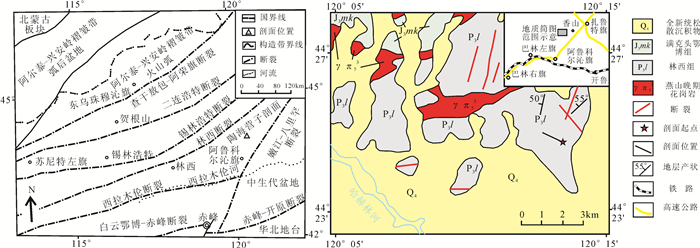
 下载:
下载:
